01/20/21
K-State Current - January 20, 2021
K-State Current is a weekly news update for the Kansas Board of Regents to apprise the Regents on a few of the many successes and achievements made by K-State faculty, staff and students.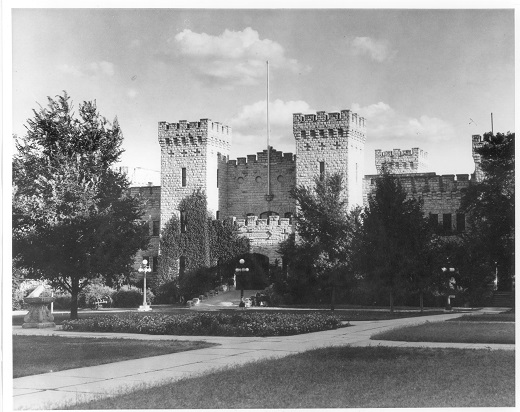
K-State News
Konza Prairie continues decades of research success with $7.12 million NSF grant renewal
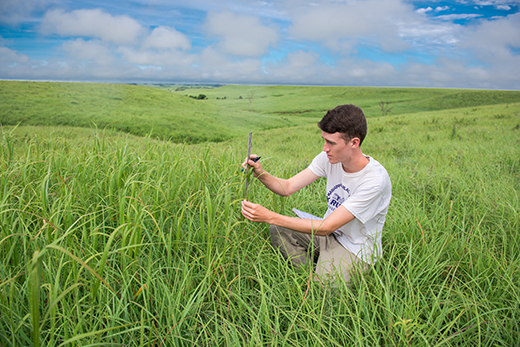 Ryan Donnelly, junior in biology, gathers measurements for research on Kansas State University's Konza Prairie Biological Station. The Konza Prairie Long-Term Ecological Research program has received a $7.12 million National Science Foundation grant renewal.
Ryan Donnelly, junior in biology, gathers measurements for research on Kansas State University's Konza Prairie Biological Station. The Konza Prairie Long-Term Ecological Research program has received a $7.12 million National Science Foundation grant renewal.
The National Science Foundation has awarded a $7.12 million grant renewal to Kansas State University's Konza Prairie Biological Station to support the next six years of long-term ecological research. The grant is the eighth consecutive NSF grant renewal for Konza Prairie and marks more than 40 years of the Konza Prairie Long-Term Ecological Research, or LTER, program.
Since 1980, the Konza Prairie LTER program has supported a comprehensive ecological research, education and outreach program. The program centers on one of the most productive, yet endangered grasslands in North America — the tallgrass prairie.
With the recent NSF grant renewal, Konza Prairie has received a total of nearly $40 million in LTER funding and leveraged an additional $60 million of federally funded research.
Konza Prairie, an 8,600-acre native tallgrass prairie research station, is co-owned by the Kansas State University Foundation and The Nature Conservancy. Faculty in the K-State Division of Biology in the College of Arts and Sciences manage Konza Prairie as a world-class platform for education and scientific investigation of grassland ecology.
"The Konza Prairie Biological Station is an amazing and critical resource for K-State," said Chris Culbertson, associate dean for research in the College of Arts and Sciences. "The recent renewal of the NSF LTER grant for an unprecedented eighth time will allow the critical long-term research underway there to continue and will allow for several new research directions to be pursued."
More than four decades of research at the Konza Prairie LTER site have produced a rich and detailed understanding of how environmental change and land management affect the structure and function of grasslands and associated groundwater and streams. Research over the next six years will build on this foundation of long-term experiments and measurements to understand causes and consequences of ecological change in tallgrass prairie. This will contribute to the sustainable management, conservation and restoration of terrestrial and aquatic resources in tallgrass prairies and other grasslands globally.
Konza Prairie was one of the original six sites of the LTER network when it began in 1980 and is one of only four original sites that are still active. There are currently 27 active LTER sites with locations around the world. NSF renews LTER programs based on a rigorous review of past productivity and the potential impact of proposed new research.
The Konza Prairie LTER program is one of K-State's most successful programs for total research output. Research conducted at Konza Prairie has led to more than 1,900 scientific publications, nearly 300 graduate theses and dissertations, and 16 books. In addition, research from this site is commonly featured in undergraduate textbooks and management-oriented publications and is used in the development of scientific theory.
The principal investigator for the Konza Prairie LTER grant renewal is Jesse Nippert, professor of biology. Co-principal investigators include Keith Gido, university distinguished professor of biology, and Lydia Zeglin, associate professor of biology. Other co-principal investigators include Sara Baer, director of the Kansas Biological Station at the University of Kansas and Kansas State University's 2014 College of Arts and Sciences Young Alumni Award recipient, and Melinda Smith, professor of biology at Colorado State University.
Konza Prairie has more than 100 active registered research projects by K-State scientists in five colleges and 14 departments as well as more than 75 visiting scientists and students from other research institutions across the U.S. and world.
2020 marks record year of engineering graduates for university
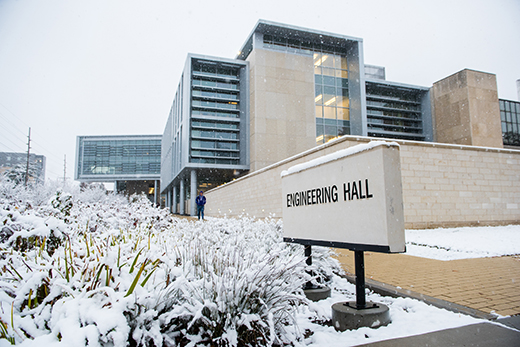 While 2020 will be remembered on many fronts, largely related to a global pandemic, the Carl R. Ice College of Engineering at Kansas State University has marked the year in celebratory mode by recording its largest-ever number of graduates and the most of any engineering school in the state.
While 2020 will be remembered on many fronts, largely related to a global pandemic, the Carl R. Ice College of Engineering at Kansas State University has marked the year in celebratory mode by recording its largest-ever number of graduates and the most of any engineering school in the state.
In awarding a total of 782 bachelor's degrees from spring, summer and fall 2020 graduation classes, the college exceeded its previous record-setting years of 2017 with 630 graduates, 2018 with 684 and 2019 with 719.
When looking for an impetus or reason behind this surge in numbers, a good place to start is the college's response to and benefit from the University Engineering Initiative Act, or UEIA, enacted by the Kansas Legislature in 2011 to increase the number of engineering graduates from the state's three engineering schools to 1,365 students per year by 2021. The goal for the Carl. R. Ice College of Engineering was 587 graduates per year by 2021, a number it first exceeded in 2017, year six of the 10-year program.
During this time period, each engineering college was required to provide a one-to-one match from non-state sources, or $3.5 million per year for each school, for a total match of $105 million over the 10 years in support of engineering education programs. The initiative ends in 2021 unless it is renewed by the current Kansas Legislature.
"The college's response to the UEIA has been nothing short of remarkable," said Matt O'Keefe, dean of engineering and LeRoy C. and Aileen H. Paslay chair in engineering at K-State. "This investment by the state legislators targeting engineering education efforts was met by our implementation of enhanced recruitment and retention programs to increase the size of the student body and support student success.
"In addition, we leveraged the funds to increase our facility size by more than 100,000 square feet of new space for classrooms, laboratories and student design team areas, as well as adding to the number of faculty serving our students."
The initiative directed the secretary of the Kansas Department of Commerce to work with the Kansas Board of Regents, as well as the three state universities, to develop a plan to target engineering education efforts to fuel economic growth and business success in Kansas.
"Demand for our graduates remains strong, with our record-setting class of 2020 continuing the tradition of a high percentage either employed or seeking additional professional education," O'Keefe said.
K-State Faculty Highlights
Food, energy, water: Researchers look for ways to combine natural resources to benefit rural towns
 Researchers at four U.S. universities have embarked on a five-year study that capitalizes on one of the Central Plains’ most abundant natural resources – wind – to store energy in ammonia.
Researchers at four U.S. universities have embarked on a five-year study that capitalizes on one of the Central Plains’ most abundant natural resources – wind – to store energy in ammonia.
They say their work – which is funded by the National Science Foundation – could help stunt the population drain that is common in many rural communities by tying together crop production, energy production and water use.
Vincent Amanor-Boadu, a professor of agribusiness economics and management at Kansas State University, said the project combines expertise of researchers at K-State, the University of Kansas, Washington State University and Western New England University.
Together, they form a project known as FEWtures, focusing on food, energy and water needs for rural communities. The group includes experts in engineering, hydrology, agricultural economics, business, political science, sociology and education.
“It is a multi-disciplinary study,” Amanor-Boadu said. “That was intentionally done because of the complexity of bringing the implications of food production, rural communities, water needs and energy requirements together.”
Listen to an interview by Eric Atkinson with Vincent Amanor-Boadu on the weekday radio program, Agriculture Today
Many parts of Kansas and surrounding states have benefitted from wind energy to power their communities. “The problem with wind is that you can generate electricity, but if you don’t use that electricity right away, you lose it,” Amanor-Boadu said.
Amanor-Boadu said the FEWtures project will capitalize on nitrogen taken from the air; use the energy from wind; combine it with hydrogen from water; and use all that to make ammonia, a compound made of nitrogen and hydrogen.
“When you do that, you are actually putting energy into the bonds between the nitrogen and hydrogen,” Amanor-Boadu said. “Then, when you want that energy back, you just split the nitrogen from the hydrogen. So, basically, you can think of ammonia as batteries.”
Peter Pfromm, a chemical engineer formerly at K-State but now working at Washington State University, is leading the ammonia-as-battery initiative of the FEWtures project. Amanor-Boadu said the ammonia produced through this process is more environmentally friendly than that produced using the industry standard Haber-Bosch process.
“When the energy stored in the ammonia is not needed, it will become available as fertilizer in food production,” he said. “Farmers could pay less for ammonia produced this way.”
Amanor-Boadu said K-State electrical engineers, led by Hongyu Hu, are working on methods to optimize production of wind captured at the local level.
“Extra energy left from the production of electricity could be used to treat wastewater that is generated in the community,” Amanor-Boadu said. “Depending on how clean you want the wastewater to be, the more energy you will need. If you treat water to the point of being able to use it for irrigation, then you are also reducing the draw of water from the aquifer.”
Amanor-Boadu and his colleagues in agricultural economics and the College of Business will be working on a decision support system to help local officials determine what is the most economical use of ammonia for their community. A livestock community may direct more of the resource toward treating water for cattle, while a crop community may choose to treat more wastewater to increase the amount of water available for agriculture.
The project is one year old, with four more to come.
“A lot of the science is already complete,” Amanor-Boadu said. “The rest of our work is calibrating these ideas to fit certain regions. The ball is in our court to build a decision support system in a way that it doesn’t have to be customized in every community, but rather you … get people’s specific realities into the model for them to make their own decisions.”
Research is currently being conducted in Kansas, Colorado, Oklahoma, Texas and New Mexico, involving 75 counties. Amanor-Boadu said the research team is seeking farmers and ranchers living in the region to participate in a short survey that is available online.
More information about the project is available online. Interested persons may also contact Susan Stover, SusanStover@ku.edu; Mary Hill, mchill@ku.edu; or Amber Campbell, ambercampbell@ksu.edu.
Recent park management and conservation grad named Presidential Management fellow
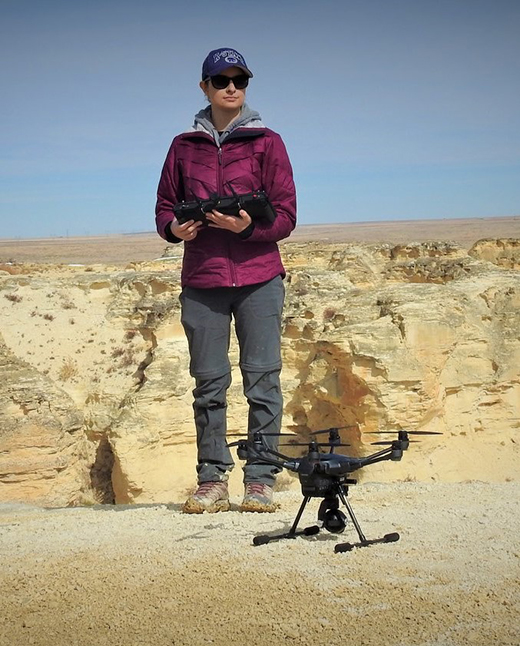 A prestigious federal fellowship will help a recent Kansas State University park management and conservation graduate with her goal of obtaining a leadership position with the U.S. Fish and Wildlife Service.
A prestigious federal fellowship will help a recent Kansas State University park management and conservation graduate with her goal of obtaining a leadership position with the U.S. Fish and Wildlife Service.
Kristen Sikorsky, a May 2020 master's graduate, has been selected as a Presidential Management Program finalist. Administered by the U.S. Office of Personnel Management, this flagship leadership development program matches outstanding graduate students with federal opportunities. Finalists are selected through a rigorous application process.
Sikorsky, Narragansett, Rhode Island, is among only 8% of the 6,800 applicants selected for the 2021 fellowship class. She applied for the program as a way to fast-track a career in federal service leadership. Through the program, finalists are matched with the federal agency of their choice for two-year fellowships and possible appointment to that agency once their fellowship has been served.
"Serving my fellowship with the U.S. Fish and Wildlife Service would allow me to contribute as a public servant within a leadership position with the agency that could make the best use of my own knowledge and talents, utilizing my skills for society’s betterment," Sikorsky said.
Sikorsky believes that safeguarding nature is as much about communicating with the public and involving a variety of stakeholders as it is about conducting research and passing laws, a belief she said is carried out in the multidisciplinary work conducted by the Fish and Wildlife Service.
"It is of great importance to me personally that I utilize both the knowledge I have gained throughout my schooling and my own personal talents to safeguard the incredible ecological diversity found in our country and preserve it indefinitely for future generations to appreciate," Sikorsky said. "The Presidential Management Fellowship is a once-in-a-lifetime opportunity that invests not only in career-level growth of fellows but personal growth as well. This program is the pathway to achieving the goals I've chased since I was young and I am so humbled to have been selected."
After earning a bachelor's degree graduate in environmental stewardship and education from West Liberty University in West Virginia, Sikorsky sought a graduate program that would emphasize supporting pristine habitats for native, endangered and rare species while allowing for tourism and recreation.
"The K-State park management and conservation program is like no other major as it allows students to pave their own path for the career they hope to one day achieve," Sikorsky said. "Not only was I able to select classes that best suited my goal and prepared me for my future career, but my professors and colleagues were always eager to communicate their knowledge and elevate the level of research conducted within our lab."
Sikorsky solidified her career interest through her thesis on ecological preservation of Little Jerusalem Badlands State Park. The newest state park in Kansas opened in 2019 and is co-managed by The Nature Conservancy and the Kansas Department of Wildlife, Parks, and Tourism. Sikorsky's research looked at improving long-term monitoring, a tool used to ensure protected habitats don't suffer from severe recreational use.
"I designed a novel protocol to test at Little Jerusalem that used drones to quickly and accurately collect indicator data — a practice that often falls to the wayside because of resource and budget limitations of conservation agencies," Sikorsky said. "Sure enough, the drone offered several benefits over traditional boots-on-the-ground fieldwork methods to collect indicator data, and ultimately helped managers to better understand the impacts unfolding at Little Jerusalem."
Ryan Sharp, associate professor of park management and conservation at K-State and Sikorsky's thesis advisor, believes she will be a tremendous asset to the Fish and Wildlife Service.
"I have known since day one that Kristen would excel in the field of conservation," Sharp said. "Few students have shown the consistent and relentless drive that Kristen has. The park management and conservation faculty are proud of what Kristen has accomplished by receiving this honor. We are also excited to see where this opportunity takes her."
In pursuing both her undergraduate and graduate degrees, Sikorsky said she was encouraged to hone her scientific writing and public speaking skills to effectively communicate her research to a broader audience. This included attending and presenting her work at five research conferences and winning the People's Choice Award at the 2019 K-State 3-Minute Thesis competition. She also was a member of K-State's chapter of the George Wright Society, which champions stewardship of parks, protected areas and cultural sites by connecting people, places, knowledge and ideas.
Alex Red Corn, Melanie Derby and Lauren McDaniel recognized as Professors of the Week
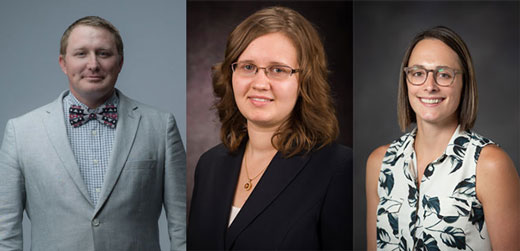 From left: Alex Red Corn, Melanie Derby and Lauren McDaniel were recognized as Professor of the Week.
From left: Alex Red Corn, Melanie Derby and Lauren McDaniel were recognized as Professor of the Week.
Alex Red Corn, assistant professor of educational leadership; and Melanie Derby, associate professor of mechanical and nuclear engineering, and Lauren McDaniel, instructor of kinesiology, were recognized as Professors of the Week at the Dec. 29, 2020, and Jan. 2 men's home basketball games, respectively. Faculty Senate, the Office of the President, K-State Athletics and the Division of Communications and Marketing wish to recognize these individuals' contributions to K-State.
Red Corn's professional life is grounded in his heritage as a member of the Osage Nation in Oklahoma where his family is from and many still live. Red Corn teaches qualitative research courses and shares his research on multiculturalism in education with a focus on the needs of American Indians. He also collaboratively created the Osage Nation Educational Leadership Academy. Red Corn serves as the K-State Indigenous Faculty and Staff Alliance co-chair, executive director of the Kansas Association of Native American Education and program coordinator of the Qualitative Research Graduate Certificate Program. Red Corn has an impressive list of scholarly publications reflecting his research on indigenous populations and multiculturalism in education. He also has represented K-State by serving as an invited speaker and on multiple panels discussing relevant pedagogies, American Indians and other indigenous people and land topics.
Derby joined K-State in 2013 and holds the Hal and Mary Siegele Professorship in Engineering. Derby enjoys teaching thermodynamics, energy and heat transfer courses at the undergraduate and graduate levels. Derby's research focuses on the heat and mass transfer as it pertains to food, energy and water. She directs the National Science Foundation Research Traineeship at K-State titled Rural Resource Resiliency. She is passionate about working with graduate students in engineering and social sciences to benefit rural communities. Derby's research has been sponsored by the National Science Foundation, NASA, ASHRAE and industry. She is a recipient of a National Science Foundation CAREER Award, K-State College of Engineering Outstanding Assistant Professor Award, American Society of Mechanical Engineering International Conference on Nanochannels, Microchannels and Minichannels Outstanding Early Career Award, and K-State Multicultural Engineering Program Faculty Engagement Award.
McDaniel joined K-State in 2008 and launched a new anatomy and physiology course. McDaniel serves as the lecture instructor and course coordinator for anatomy and physiology while also teaching multiple Kinesiology elective courses. McDaniel also oversees internships in kinesiology and serves as the coordinator of the Exercise is Medicine on Campus initiative. Under McDaniel's guidance, the initiative has received Silver-level recognition from the American College of Sports Medicine for the past two years. McDaniel is the winner of the 2020 Myers-Alford Teaching award from the College of Health and Human Sciences as well as the past recipient of multiple development grants from K-State Global Campus.
K-State Student News
Architecture students win scholarships in ninth annual MANKO Design Competition
 Two architecture students in the Master of Architecture program in the College of Architecture, Planning & Design, or APDesign, received scholarships in the ninth annual design competition sponsored by MANKO Window Systems, hosted virtually on Dec. 4.
Two architecture students in the Master of Architecture program in the College of Architecture, Planning & Design, or APDesign, received scholarships in the ninth annual design competition sponsored by MANKO Window Systems, hosted virtually on Dec. 4.
Justin Grim, a fourth-year architecture student, Schnecksville, Pennsylvania, is receiving a $5,000 scholarship as competition winner for his project "Sybiosis, Genesis Center and Abiotic Development and Application" from associate professor Genevieve Baudoin's studio. The design was an assignment in his fourth-year comprehensive studio class, requiring students to integrate conceptual and technical knowledge into a highly resolved building proposal.
Riley Griggs, a fourth-year architecture student, Clay Center, is receiving a $2,000 runner-up scholarship for his mid-rise mixed-use project in Austin, Texas for assistant professor, Grant Alford's studio.
Following a review, one student from each of the department's five fourth-year studios was selected to compete for the MANKO awards, with each developing a narrative slide presentation to present to jurors, who were all established practitioners in the field.
The competition jury included Charles Di Piazza, lecturer, University of Texas architect and founder, Charles Di Piazza Architecture, Austin, Texas; Malcolm Watkins, architect and vice president, SJCF Architecture, Wichita; Kristina Yu, associate professor and associate dean, University of New Mexico Architect and principal, McClain + Yu, Albuquerque, New Mexico.
The following architecture students also were selected for the MANKO Design Competition:
Beau Constant, Stilwell, representing the studio of Cameron Tross, visiting assistant professor of architecture; Somnath Mukherjee, India, representing the BNIM studio; and Salim Akli, Algeria, and Justin Cresswell, Bristow, Virginia, representing the summer studio of Grant Alford, assistant professor.